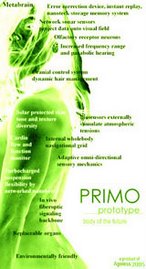As mentioned in the previous blogpost, there are various crossovers between technology and biology. This merger has given rise to ‘sciences of the artificial’, such as artificial intelligence (AI), and artificial life (Alife).
You might be familiar with the Steven Spielberg movie Artificial Intelligence: AI (2001), whereby a highly advanced robotic boy longs to become "real" so that he can regain the love of his human mother.
AI scientists predict that intelligent or ‘thinking’ machines can be created- and will be in the near future. However, humanists argue that machines are programmed to calculate solutions, and this does not qualify as thinking in the traditional sense. They argue there is no thinking in a machine, “only electrical charges exchanging input and output signals”[1]. AI scientists respond by pointing out that this is exactly how neuron activity in the brain also works; and don’t we consider this thinking?
There are two forms of AI: Classical AI, and Connectionist AI. Classical AI is concerned with the imitation of human intelligence in machines. The science claims to translate ‘the language of thought’ into computer programs. Connectionist AI on the other hand is concerned with the mere creation of intelligent machines, be it resemblance of human intelligence or not. Instead of replicating human intelligence, the science simulates the functions of human organs.
Alife replicates traditional biology by recreating biological phenomena. The science simulates biological systems relating to life through computer models, robotics, and biochemistry. Hence, there are three main kinds of Alife: soft from software, hard from hardware, and wet from biochemistry. According to Alife scientist John von Neumann, "life is a process which can be abstracted away from any particular medium"[2].
From the three abovementioned sciences of artificial life it is clear that technology has had to veer towards the physical (and not away from it) in aiming to serve the human culture.
I believe that it is this fresh understanding of artificial life that will open up people to the possibilities presented by AI and Alife, instead of fearing them.
References:
[1] Lister, M (ed). 2003. New Media: A critical Introduction. Routledge.
[2] Wikipedia-Artificial Life
Subscribe to:
Post Comments (Atom)

5 comments:
I'm not a big fan of the AI phenomenon and there is a fear that technology will start thinking for itself - I don't think it will ever reach that point personally but hopefully, if it does, I'll be long gone:) Interesting post ...
reading your blog reminded me of the movie I,Robot. Although I think that 'thinking robots' are a possibility, I dont believe that it will happen during our lifetime. It's all a bit too science fiction for me!
There will always be space for robots to replace humans particularly where machines are capable of mass production for higher productivity at lower cost. Robots won't replace human beings as long as it's economically viable to exploit others to perform routine but individualised tasks like ironing clothes, sweeping under the rug and digging for gold. AI robot technology is still too expensive to consider to use for menial tasks or functions, but early AI embedded in software that helps humans become more efficient or productive in our decisions and behaviour is far more useful.
85cc免費視訊聊天78免費視訊5i176免費視訊秀5i176 免費視訊秀520免費視訊mm17iavhigh免費視訊聊天室avshow 免費視訊聊天avshow免費視訊聊天男人免費視訊男同志免費視訊聊天室男同志免費視訊聊天男同志免費視訊片免費aa免費視訊聊天論壇無碼免費視訊辣妹無碼免費視訊ㄧ對一免費視訊a免費視訊聊天網av博物館,免費視訊美女av免費視訊辣妹av免費視訊短片av免費視訊520免費視訊meet 520520sex免費視訊13060 免費視訊聊天1069免費視訊聊天104免費視訊辣妹脫衣秀104免費視訊聊天1007免費視訊080免費視訊介紹聊天室080免費視訊聊天室080免費視訊聊天080免費視訊0509免費視訊聊天網0509免費視訊聊天秀0509 免費視訊聊天網0509 免費視訊聊天秀168 免費視訊優女聊天室168免費視訊網168免費視訊辣妹38girl免費視訊聊天偷拍走光論壇偷拍貼圖貼片偷拍貼圖站色聊天線上看a影片a免費圖片免費av遊戲色視訊美女視訊短片
美女視訊用品娜娜
美女視訊聊天奇摩聊天室中文 u 遊戲盒子
美女視訊聊天fm358
美女視訊電話
美女視訊脫衣
美女視訊聊天室 ilover99 論壇
cf視訊
視訊往
聊視訊
看視訊
blog is great~~祝你人氣高高~.................................................................
Post a Comment